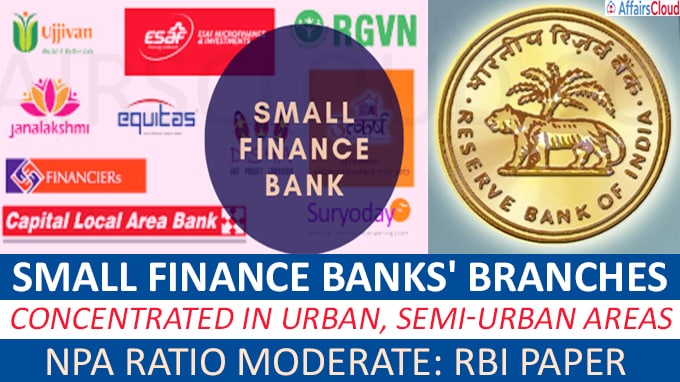 In accordance with an article ‘Small Finance Banks: Balancing Financial Inclusion and Viability’ published in Reserve Bank of India’s (RBI) monthly bulletin on January 21, 2021, the assets of Small Finance Banks (SFBs) between financial years (FY) 2017-18 and 2019-20 have grown 150% annually. Their share in total assets of the financial sector stood at 0.4% in March 2019.
In accordance with an article ‘Small Finance Banks: Balancing Financial Inclusion and Viability’ published in Reserve Bank of India’s (RBI) monthly bulletin on January 21, 2021, the assets of Small Finance Banks (SFBs) between financial years (FY) 2017-18 and 2019-20 have grown 150% annually. Their share in total assets of the financial sector stood at 0.4% in March 2019.
- The article prepared by Richa Saraf and Pallavi Chavan from the RBI’s Department of Supervision provided an overview of SFB’s business between FY 2017-18 and 2019-20.
Branches Concentration of SFBs:
There has been rapid growth in the branch network of SFBs. The number of branches of SFBs rose to 4,307 by March 2020, but they are concentrated in urban and semi-urban areas with limited penetration in rural and smaller semi-urban centres. In Urban and semi-urban areas also they are concentrated in Tier 1 to Tier 3 centres having populations of 20,000 persons and above.
- In March 2020, about 39% of the total SFB branches were semi-urban areas followed by 26% in urban centres, and 18% in Tier 5-6 (rural) centres with a population of less than 10,000 persons.
Regional Front:
In regional front also the growth in branch network of SFBs has been concentrated in the India’s well-banked regions i.e. southern (highest), western and northern regions while it is lacking in the north-eastern region which is also known as least banked region.
State Front:
At the State level, they are concentrated in Tamil Nadu (16.6), Maharashtra (13.1%), Rajasthan (8%), Karnataka (7.7%), Madhya Pradesh (7%), Kerala (5.5%) and Punjab (4.7%)
Non-Performing Assets (NPAs) of SFBs
The bad loan ratio or NPA ratio is low among the freshers of India’s financial system. Notably their NPA remained moderate since inception, which states a healthy asset quality.
- In March 2020, 99.9% and 83% of SFBs total loan accounts and total loan amount, respectively, had a credit limit of up to Rs 25 lakh.
- It should be noted that RBI guidelines specify that SFBs must have at least 50% of their loan book in the Rs 25-lakh category.
CASA of SFBs
Their percentage of current accounts and savings accounts (CASA) remains lower than other Scheduled Commercial Banks (SCBs). The share of CASA in total deposits for SFBs stood at 15% in March 2020 as compared to 41% for other SCBs.
Serving the Priority Sector:
The SFBs are catering to priority sectors like agriculture, small scale trade and professional services, which are relatively under-served by scheduled commercial banks. These three sectors accounted for about 65% of the total credit of SFBs in March 2020.
- It should be noted that as per SFBs licensing guidelines at least 75% of the adjusted net banking credit to be in the PSL compared to 40% for universal banks.
- Even within the industrial and services sector credit, these banks have succeeded reasonably in reaching out to MSMEs (micro, small and medium enterprises).
- As of March 2020 about 41% of total loans by SFBs were to small businesses.
Story of SFBs:
The RBI issued licensing guidelines for SFBs in 2014, following which 10 SFBs have commenced operations so far.
- The first two SFBs are Capital Small Finance Bank based in Jalandhar, Punjab and Equitas Small Finance Bank headquartered in Chennai, Tamil Nadu, who started operations in 2016.
Additional Info:
–Private sector new projects have risen by 8% in Q3FY21, while the same fell by 71% in the government sector.
–Indian economy is projected to contract by 7.7% in FY21, as per the first advance estimates of GDP (Gross Domestic Product) by National Statistical Office (NSO), Ministry of Statistics and Program Implementation (MoSPI).
Click Here for Official Article
It should be noted that the views expressed in the paper are those of the authors and do not reflect any point of RBI.
Recent Related News:
i.RBI announced to increase the limit for contactless card transactions and recurring payment mandates through cards and unified payments interface (UPI) to Rs 5,000 from Rs 2,000 earlier from January 2021.
ii.In December 2020, RBI decided to extend on-tap Targeted Long-Term Repo Operations (TLTRO) by bringing 26 stressed sectors identified by the Kamath Committee under the chairmanship of Kundapur Vaman Kamath in order to provide more liquidity in the economy.
About Reserve Bank of India (RBI):
Formation– 1 April 1935
Governor– Shaktikanta Das
Headquarters– Mumbai, Maharashtra
Deputy Governors– 4 (Bibhu Prasad Kanungo, Mahesh Kumar Jain, Michael Debabrata Patra, and M Rajeswar Rao)




